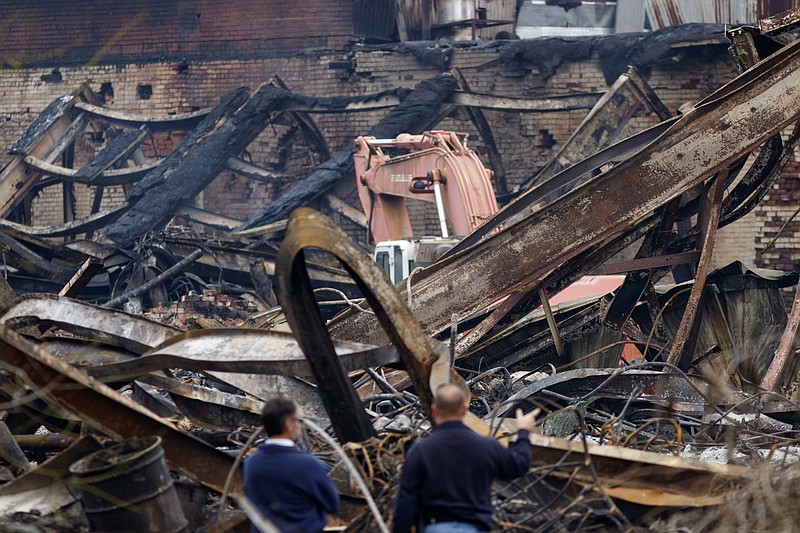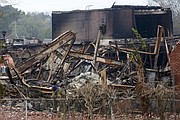Cleaning up the old Barwick Mills plant that erupted in flames in downtown LaFayette, Ga., on Nov. 14 is expected to take at least six to nine months and could get trickier if asbestos is discovered on the site, still soaked by the water used to fight the fire.
A 181-page report released Thursday by the U.S. Environmental Protection Agency summarized the initial environmental effects of the fire, as focus turns to what is likely to be a grueling and tedious cleanup process.
"There are a lot of questions to answer," LaFayette City Manager David Hamilton said, adding that six to nine months is a reasonable but aggressive goal. "There is a tremendous amount that has got to be done."
A fire, its cause still unknown, started in the southern portion of the 250,000-square-foot building on the afternoon of Nov. 14 and smoldered for days until rain finally helped extinguish the final remnants on Nov. 18.
Firefighters poured up to 5,000 gallons per hour onto the blaze, and the runoff turned the nearby Chattooga River a filmy blue color.
Crews were able to protect two 10,000 gallon tanks of oil from becoming engulfed in the flames and perhaps exploding violently. But explosions involving other materials, some of which may still not be known, raised particulate levels high enough that EPA told LaFayette to issue a stay-indoors recommendation to those living near the fire.
The EPA report assembled by TetraTech, the company that handled air and water testing on the site, confirmed that air quality was unsafe the day after the fire. The air quality returned "good" on Nov. 17, according to the report.
Weeks later, 150,000 gallons of water remain on site, where a separate partially destroyed former textile and carpet mill is now under the care of two companies, Global Environmental and Maxis Engineering, charged with cleaning up.
A Chattanooga-based product development company called Ashgan Products, which specializes in reusing biodegradable products, was leasing the south side of the building and lost about $250,000 worth of products in the fire.
City and state officials said Ashgan Products and the building's owner, which Walker County property records show as Crutchfield Properties LLP, will be responsible for paying for the cleanup. The specifics of the cleanup, including a more precise time line, will be settled when more samples from the site have been returned, Hamilton said.
Representatives from Ashgan Products and Crutchfield Properties could not be reached for this story, and representatives from Global Environmental and Maxis Engineering did not return phone calls last week.
City and state officials have requested ongoing oversight from the EPA to ensure the cleanup goes smoothly, said Brian Englert, the initial on-scene coordinator for the federal agency.
"They're probably going to have to clean debris out to get to stuff that's still in the building," Englert said. "Probably a large part of the idea would be to prevent additional runoff and to deal with asbestos if it's there. Once it burns like that, you don't want to leave all of that stuff open to the environment."
Officials know that polypropylene, polyethylene, calcium carbonate and foam were stored in the building, because that's what Ashgan Products kept there. Officials say those chemicals aren't especially fearsome.
What previous tenants may have left behind remains unclear, although the federal Emergency Planning and Community Right-to-Know Act mandates that companies that release toxins disclose how many pounds of toxins they are releasing. That law passed in 1986.
"The textile manufacturer, they would have occupied probably most of that facility and they're bankrupt or no longer in existence, so yes, that sort of thing becomes an issue," Englert said. "If they leave stuff behind, it might not be noted or taken care of."
Hugh Galyon, a representative from Georgia's Environmental Protection Division who toured the site last week, said the focus for now is centered on what is known to have been in the building.
"We're just going to work with what was known to be there, unless some of the samples send us in a different direction," he said.
Galyon added that the state's primary concern is minimizing the impact to state waters, which means keeping the remaining runoff from entering the Chattooga River.
State officials are still waiting on a report detailing the number of fish killed by the initial runoff. A fine could be assessed to the building owner or Ashgan Products based on what that report shows, Galyon said.
Hamilton added that the city is concerned about keeping people from getting onto the site, where they could get hurt by the twisted wreckage that remains.
"Our primary concern is taking care of the community and making sure the cleanup is done properly and that the area is secure and also protecting any possible hazards from getting out into the community," he said. "That's really going to be our involvement, is making sure the cleanup is done properly."
Contact staff writer David Cobb at dcobb@timesfreepress.com or 423-757-6249.

